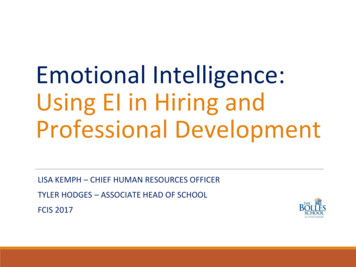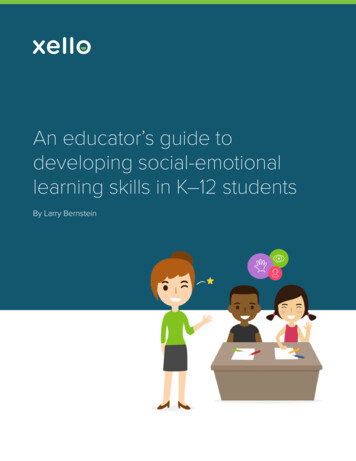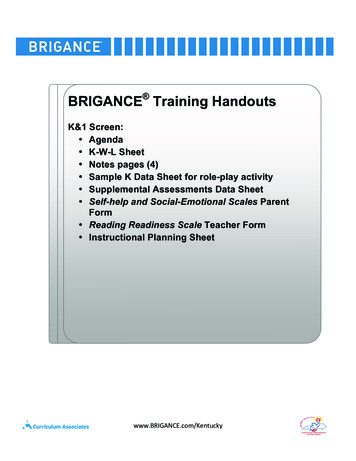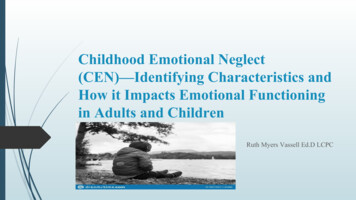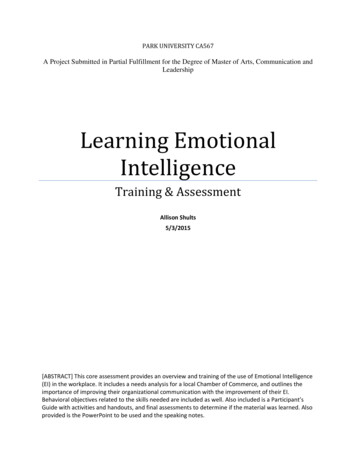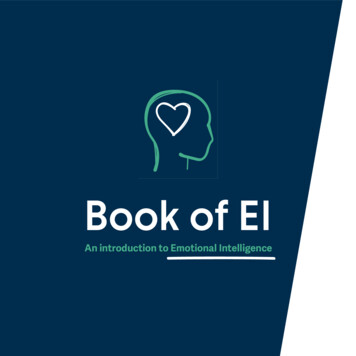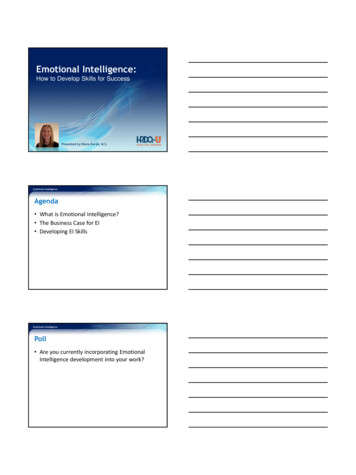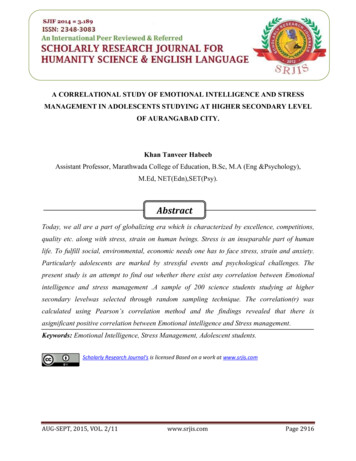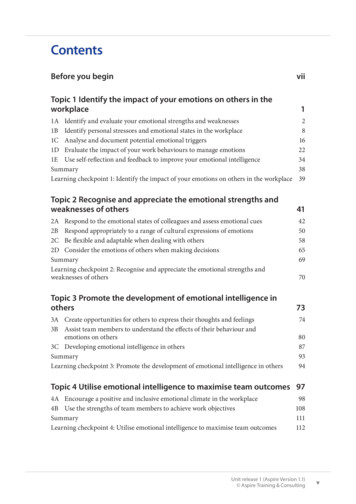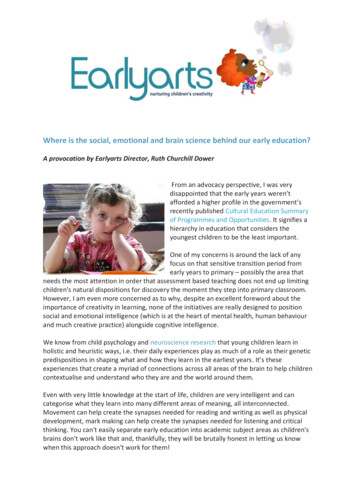
Transcription
Where is the social, emotional and brain science behind our early education?A provocation by Earlyarts Director, Ruth Churchill DowerFrom an advocacy perspective, I was verydisappointed that the early years weren’tafforded a higher profile in the government’srecently published Cultural Education Summaryof Programmes and Opportunities. It signifies ahierarchy in education that considers theyoungest children to be the least important.One of my concerns is around the lack of anyfocus on that sensitive transition period fromearly years to primary – possibly the area thatneeds the most attention in order that assessment based teaching does not end up limitingchildren's natural dispositions for discovery the moment they step into primary classroom.However, I am even more concerned as to why, despite an excellent foreword about theimportance of creativity in learning, none of the initiatives are really designed to positionsocial and emotional intelligence (which is at the heart of mental health, human behaviourand much creative practice) alongside cognitive intelligence.We know from child psychology and neuroscience research that young children learn inholistic and heuristic ways, i.e. their daily experiences play as much of a role as their geneticpredispositions in shaping what and how they learn in the earliest years. It’s theseexperiences that create a myriad of connections across all areas of the brain to help childrencontextualise and understand who they are and the world around them.Even with very little knowledge at the start of life, children are very intelligent and cancategorise what they learn into many different areas of meaning, all interconnected.Movement can help create the synapses needed for reading and writing as well as physicaldevelopment, mark making can help create the synapses needed for listening and criticalthinking. You can't easily separate early education into academic subject areas as children'sbrains don't work like that and, thankfully, they will be brutally honest in letting us knowwhen this approach doesn't work for them!
It's important to bear in mind that we onlyunderstand a tiny amount about the youngbrain so far. This is partly because it is notconsidered ethical or safe to put babies intoFunctional Magnetic Resonance Imaging(fMRI) scanners unless a serious conditionrequires immediate analysis of their brainsas, a) it's very difficult to keep a baby stillunless its asleep, and, b) we still don't knowwhat adverse impacts the strong magnetscould have on a baby's brain.However, the next ten years will enable aplethora of new research to emerge aboutbaby's brains as a new type of scanner becomes available. This will introduce a scanningtechnique called the Near-Infrared Spectroscopy (NIRS) approach, used in parallelthe magnetoenchephalography (MEG) system although the magnetic field strength will bemuch reduced for use with babies. A handful of expert neuroscience and medical expertshave been selected for training in the use of this equipment in Switzerland, so we can lookforward to their research results in due course. One such expert is Dr Efthymios Papatzikis,who I'll introduce you to shortly.In the meantime, I am very interested in researchers who are exploring what conditionsseem to enable children's brains to work best, and how strongly their emotional healthfeatures in this. A number of existing studies refer to the way different people show atendency towards a predominant hemisphere, i.e. they are more of a right brain (creative)or a left brain (algorithmic) person. Certainly early creative and emotional intelligence testsby Gardener (Harvard), Salovey (Yale), and Meyer (New Hampshire) confirmed this bymeasuring responses to standard questions such as 'name ten things you could do with abrick, or a paper clip'.However, as we know, younger children's imaginary capacities seem to develop muchearlier than their algorithmic skills, and I suspect they would be brilliant at this exercise.Their answers would probably only be limited by the requirement to name ten things, ratherthan 100! So from this we could assume that all young children are predominantly rightbrain people.Of course, that's not the case but then these testsweren't necessarily designed to be used withyounger children, and I suspect other 'tests' ofcreativity, such as the Torrence tests, would alsoresult in very skewed results. This is partly becausethey do not take into account the way youngchildren's brains (both sides) are still developing atan exponential rate until the pruning process beginsaround the age of three and children's retained
knowledge starts to become more specialised. It is also to do with the fact that manycreative processes, such as music making, can be triggered from activity in the amygdala,the emotional centre of the brain. Thankfully, insightful editors such as Christian Jarrett areexposing some of the myths relating to the functionality of the brain.Psychologist and science journalist Daniel Goleman moved beyond these traditional tests,proposing that emotional intelligence is at the heart of brain development, and therefore,human behaviour. He defined it as 'the capacity for recognising our own feelings and thefeelings of others; for motivating ourselves and managing emotions effectively'. Hisevidence showed that the processes towards, and outcomes of, emotional intelligence canreduce stress, decrease conflict, improve relationships and increase stability – especially infamilies. Emotional Intelligence sounds to me, therefore, like an excellent core principle forthe Early Years Foundation Stage and the National Curriculum – can you imagine howsuccessful these could be if taught with the objective of reducing stress and improvingstability and mental health? Perhaps the traditional objectives of academic and economicsuccess would be achieved four-fold if we got our children's emotional, mental and chemicalstates balanced first.Being married to a scientist whofrequently asks me to explain myassumptions, I am fascinated with both thescience and the aesthetics of early braindevelopment. Sometimes I am convincedwe can explain everything through science,including what makes us be or feelcreative. Maybe that's just the need in meto try and lead a simpler life! At othertimes I believe in the power of the arts totranscend scientific explanation andprovide an experience so beautiful and fulfilling that I don't have (or need) the words toarticulate it, the experience is enough.This experience seems to reside in a completely different part of the body than the brain,such as a sensation in my arms or my diaphragm, possibly due to the number of nervereceptors there. There's a great article in the New York Times on how our emotionalresponse to music can cause the release of the neurotransmitter dopamine deep within thereward centre in our brain.So, when I think about what conditions enable children to be their most creative, I amconstantly trying to weigh up what we can prove through evidence based knowledge, andwhat we cannot prove but can feel, sense, see or somehow intuit through our experiencescoupled with historical and contextual knowledge that help us make sense of theexperience. It's a bit like trying to find whether there's any common ground betweenChristianity and Atheism, one based on faith and the other on a lack of faith, both havingequally strong believers and very few middle-grounders.
Recently I was invited to speak aboutthe impacts of the arts in earlychildhood to teachers at the BotinFoundation Summer School inSantander. Here I had the privilege ofmeeting cognitive neuroscientist ofmusic from Harvard University and theUniversity of London, Dr EfthymiosPapatzikis, who is conducting researchinto the specific impacts of certainmusical interventions on babies'cognitive and social development. Hetold me a little known fact that thebrain holds four memory systems (thelong and short working memories, the episodic and semantic memories) which creatememories based on positive or negative experiences, each of which can trigger certainreactions in young children depending on how well connected and reinforced thesememories become.It is thought that the storage of memories depends on whether they are formed from abasis of love or fear, from which pretty much every other emotion we experience stems. It isalso thought that there is a direct relationship between the development of physicalmemory, emotional memory, auditory memory, kinaesthetic memory and musical memory,and the strength of that relationship determines how easily we can then access thosememories when we need them.Dr Papatzikis confirmed that the two hemispheres are closely connected in every brain dueto the fact that memories we recall every second of our lives in order that our bodies andminds can function, come from complex connections across both hemispheres. Thishappens in conjunction with the triggering of different chemical sets, which have a directbearing on our physical and emotional state of being. He suggests that everything can betaught, i.e. we can learn to over-ride previous dominant tendencies, to provide a betteraccess to knowledge across the hemispheres and, whereas he agrees that we may have adisposition to learn from one particular teaching style over another, we nevertheless storethe information we learn right across both parts of our brains.An illustration of how this works: Anyonewho knows me will know how terrible mymemory is for people's names. Nothing else,just names. It's so extreme, I often find myselfasking very old friends to remind me of theirname when I'm telling a story involving them.I thought that names were simply stored inthe memory bank that resides in the leftfrontal lobe and I couldn't help but wonderwhether the accidental drop on my head atthe tender age of two had something to do
with this. We will probably never know, but it is a constant source of embarrassment for meand opportunities for humiliation by my friends! It turns out that names, as with muchinformation, are stored in several different places.Storing and recalling a name requires a process of attention, followed by the placing of thename in the short term memory, which leads to an experiential or sensory attachment tothe name, which then encodes the name in the long term memory. This requires a series oflinkages and connections to be set in the frontal lobe, rehearsed in a sequence of events inthe left Hippocampus and finally recalled by working in conjunction with the visual memoryin the right neocortex and verbal memory in the language centre if we want to articulate thename. This, of course, doesn't take into account the other factors affecting name recall suchas genes, hormones, sleep, stress, diet, and age, for example.However, I have found I can overcome thisshortcoming by writing names down (mainly inmeetings) and so, by seeing a name in visual form, Istore the memory of the shape of the word in adifferent part of my brain that I can recall in myminds' eye in an instant. I suppose you could saythat I am a very visual person, because I can storeand recall visual memories easily, which thentrigger other memories. I am also a very auralperson with strong recollections triggered bysounds.For instance, I can pretty much remember all the songs from Joseph and His TechnicolourDreamcoat, my first primary school musical at the tender age of 5, having learnt to singthem by rote before I could write. I would say I also have a strong emotional and moralcompass – I am sensitive to what I feel about people or things, how other people feel, I tryto build trust, to focus on the positive and to mediate any potential conflict. I would saythose are the three strongest faculties or 'intelligences' in my brain that I use to trigger andrecall memories. For others, smell or colour are also key triggers for memory. Just like ourcultural identities, our memories are complex and multi-faceted and, as such, are made upof many different elements within the brain.So you can see where I'm going with this.We now have a decade of researchgathered from fMRI scans that show theundeniable connectivity between manydifferent parts of the brain in order forboth simple and complex functions to takeplace. We also know a small but importantamount about how the brain changes andgrows even later on in life, during sensitiveperiods of 'plasticity'. From this we cansurmise that learning is not a linearprocess, facts are not stored in isolation
from our other intelligences, whether they are visual-spatial, kinaesthetic, musical,interpersonal, intrapersonal, linguistic, mathematical or emotional.Therefore, knowledge and skills surely cannot be successfully taught without anunderstanding of the social and emotional connectivity behind remembering,contextualising, understanding and recalling knowledge. As a learning framework, theNational Curriculum does not seem to cater for this either in the way it is measured andassessed, or in the way teachers are expected to build the knowledge and skills required intheir students. The Early Years Foundation Stage recognises it to a degree, but is limited bythe training of early educators and child carers in this country.In the Cultural Education Summary of Programmes and Opportunities, there are a veritablenumber of organisations, initiatives and outputs, identifying what a child should have accessto in terms of a cultural education. But what is so disappointing, and yet again misses thefundamental reason for the whole argument, are the outcomes – why cultural education isso important, and the benefits it brings to children as learners, individuals and members ofsociety on social, emotional, physical, spiritual, artistic and cognitive levels. Surely, that's themost important headline?Written by Ruth Churchill Dower ,Published by Earlyarts UK, July 2013.Excerpts can be reproduced for private or non-profit trainingpurposes only. Please quote the full source if referencing thisessay, and let us know at info@earlyarts.co.uk.www.earlyarts.co.uk
It is thought that the storage of memories depends on whether they are formed from a basis of love or fear, from which pretty much every other emotion we experience stems. It is also thought that there is a direct relationship between the development of physical memory, emotional memory, auditory memory, kinaesthetic memory and musical memory,



